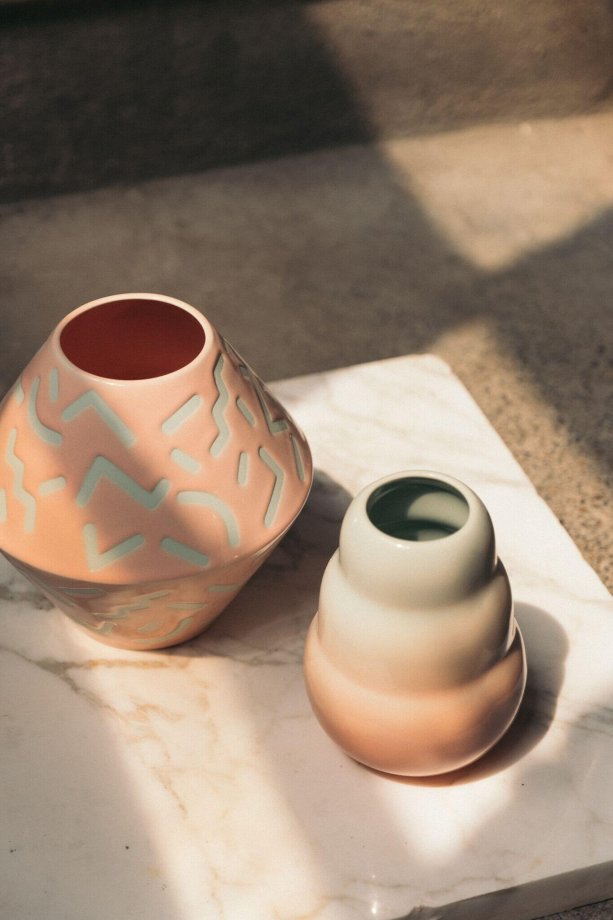Making Space: The Collaborative Energy Behind CKTC Ceramics
CKTC Ceramics is comprised of just two artists: Cincinnatians Colin Klimesh and Taylor Carter. But everything they make pulses with a sort of wild collaborative energy that feels bigger than what two young Midwesterners should reasonably be able to create in a single cramped studio. Whether they’re sculpting sinuous vases in ‘90s-cartoon pinks or weed pipes elegant enough to be featured in the pages of Vogue, Klimesh and Carter ride the line between humor and high art.Roping in references from their favorite Instagram accounts to the 1980s Memphis design movement shows CKTC has spent time fleshing out their point of view. But they are only getting started. We chatted with these hungry young artists as they begin to open up to an even wider world of influences.
tripoter-min
Taylor, you’re almost a decade younger than Colin, and you started as his studio assistant when you were still an undergraduate. What’s it been like moving into a creative partnership?
Taylor Carter: It’s been pretty smooth, because we both have our strengths. Colin’s really good at the 3-D printing part, which is a big part of our process, and I do a lot of the design stuff—trying to figure out where we could go next, what’s new. Colin helps bring that to life. We do the production together—the cleaning, the casting, the glazing. We play off of each other’s strengths and weaknesses.
Colin Klimesh: That’s true. I’ll say something like, “We should really make something that does this”—say, something that you can put whiskey in—and then Taylor will say, “But wouldn’t it be funny if that flask was bright pink and ceramic?” My first starting point is always the function, and Taylor says, “Cool, but I’m going to turn that sideways and make it a little bit wonky.”
What’s inspiring you lately?
TC: I’m really into neoclassical ceramics, but I feel like a lot of it has been done so many times over. I’m trying to find ways to flip those shapes into a more fun aesthetic. Like color—I love midcentury design and the colors that were popular during that period, the chartreuses and mustards.CK: Up until the last five years or so, ceramics, as a medium, has never been able to cycle through and reference ideas. But Instagram—and the way it lets you view the work of young ceramic artists—has changed all of that; we can look inside one another’s studios, check out processes in a way we just couldn’t before, and nod to each other’s work a lot more easily now. I can look at a concrete artist who did something really cool and say, “Wow, how can I arrive at that?” I could gorge myself on material and process forever. That’s exciting to me.
tripotomb-min
What excites you about being an artist in Cincinnati?
TC: Cincinnati is a really good place to be right now. There are a lot of cheap spaces where you can make work and organizations who are encouraging artists to keep up their momentum. When Attilio D’Agostino [ALIVE’s Editor-in-Chief] was here, I was telling him about all the stuff in the city, and I just realized how connected everything is. I told him, “You should go to this restaurant! And this company does their fur- niture, but they also have a store. And the store sells this person’s work, and they also made the dishes for that other restaurant ...” It goes on and on.
Tell me about the collaborative studio space you’re starting, OTOT.
TC: I’ve really missed working in a communal studio lately. Our old studio was okay, but it’s a little dusty and grimy in there, so it’s not a place where I want to hang out, and that doesn’t motivate you to show up every day. I wanted to create a space that we wanted to be in.
doupot-min
CK: This is the kind of opportunity that Cincinnati offers. If you need a space, and you don’t have a lot of cash, you can get something that’s not ideal, but you can make it better. We’ve definitely struggled through a lot of cold winters without heat and with gross bathrooms, and the whole time, we’ve just been putting those vibes out into the universe that we’re looking for something better. After a while, I think Taylor started to think, ‘We have to make that space.’ Once she got that in her mind, we knew we’d be taking a risk, but we needed to do it.It’s been a lot of work, but it feels like things are lining up. Not just in terms of physically moving to this studio, but in terms of moving the business into the next stage. Maybe bringing on some help to do some larger projects, to be more nimble.TC: Definitely. A lot of exciting things to come.
Photography by Attilio D'Agostino.
This story originally appeared in ALIVE Issue 4,
.



